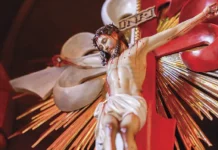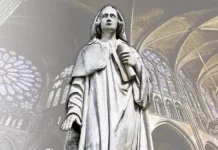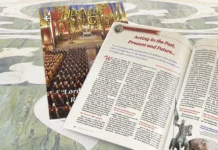Why is it that St. Padre Pio attracted and still attracts so many souls? Perhaps because his life was entirely dedicated to prayer, to the celebration of the Holy Sacrifice and the administration of the Sacrament of Penance.
Pietrelcina is a small town in southern Italy, surrounded by fertile but rocky land. Even today, walking through its narrow, unevenly surfaced streets, one can feel the atmosphere of bygone days.
On May 25, 1887, this obscure locale became the birthplace of a boy, baptized by the name of Francis, whose fame, over the years, was to spread far and wide.
He would be the “martyr” of the confessional, who had the gift of reading consciences and spent ten to fifteen hours a day administering the Sacrament of Reconciliation; the persecuted priest, who for a little over two years was forbidden to celebrate his daily Mass in public, to hear Confessions or even to give spiritual advice to those who requested it; the religious who kept obedient silence in that situation; the Capuchin friar sought by crowds that flocked from all over the world: St. Pio of Pietrelcina.
To all this can be added the fact that he bore in his hands, feet and side the clear, supernatural and painful sign of the stigmata, which marked his life and apostolate for fifty years.
“I am only a poor friar who prays”
Pope Paul VI commented on this monk with the stigmata, who astonished and still amazes the whole world:
“Look what fame Padre Pio had! […] But why? […] Because he celebrated Mass humbly, heard Confessions from morning till night, and was a visible representative of the stigmata of Our Lord. He was a man of prayer and suffering.”1
One of his biographers sums up his existence in this way: “a kneeler, an altar and a confessional.”2 These three words indicate the places where he spent most of his days, dedicated to prayer, to the celebration of Holy Mass and to attending to the thousands of penitents who knelt to ask forgiveness, as well as to gain some insight on the direction of their lives.
Padre Pio prayed at every moment and everywhere. This was the source from which he drew his strength. “What do these people want from me? I am just a poor friar who prays,” he said of himself.
He lived of the Mass and for the Mass
The Masses celebrated by Padre Pio were a wonderful spectacle of piety and faith. He would go up to the altar without the gloves that normally covered the stigmata of his hands, and those who were able to contemplate him on those occasions never forgot it. The faithful crowded at the entrance of the church two hours before the beginning of the Holy Sacrifice, in the hope of getting front row seats; everyone left having grown in devotion.

It is said that Padre Pio lived of the Mass and for the Mass. In this regard, in the 1950s the French Ambassador to the Holy See declared: “Never in my life have I attended so disconcerting and yet so simple a celebration. […] The Mass acquired unknown proportions and became an absolutely supernatural act.”3
More than to listen to his homilies, the faithful flocked to participate in the celebration, which was, in itself, a preaching. Everyone wanted to have contact with him. On his way to the altar or to the confessional, they tried to touch him, they crowded around him, they told him their sorrows, and they asked for guidance.
When, in September 1916, he arrived at San Giovanni Rotondo – called the “convent of desolation”, by a Capuchin of the time owing to the scarcity of the faithful who then frequented its church – no one could have imagined that, years later, crowds would gather there, avid to attend its Masses and make their Confession. They longed to receive spiritual advice, solve family problems, or even to be the object of a miracle.
“Martyr” of the Sacrament of Reconciliation
The testimonies of penitents who confessed to Padre Pio reveal how severe he was with those who were neither convinced of the gravity of their sin nor determined to abandon it. At the same time, he showed himself to be paternal, understanding and encouraging with those who repented of their weaknesses.

Some of those who came to him were met with attitudes that they may have found disconcerting, but this did not discourage them: they invariably returned to him. “It is a sin, it is a sin” – he used to repeat to those who received the Sacrament of Reconciliation – “If you do not want to stop offending God, what are you doing here?”
Padre Pio’s penitents came not only from nearby towns, but also from all over Italy and even abroad. As their number kept increasing, it was decided to issue numbers and make a schedule. On some days, the time he devoted to hearing Confessions would extend to sixteen hours! In 1967, he confessed about fifteen thousand women and ten thousand men, about seventy people a day.
“I am besieged by a multitude of souls thirsting for Jesus,” he commented to his companions. “They don’t leave me one free moment.” The gift of reading consciences and probing hearts made him famous: “I know them inside and out,” he acknowledged. When approached by those who had not confessed for a long time, he reminded them of their forgotten sins.
Padre Pio spent a great part of his life in the confessional, listening to human miseries and sorrows with admirable patience. He can be considered a “martyr” of the Sacrament of Reconciliation. “I feel fine, but I am overwhelmed with hundreds and thousands of Confessions that I hear day and night. I do not have an instant for myself,” he once declared.
Sent by God to convert the people
Exhausted by his generous giving of self to his brethren, the Capuchin of the stigmata expired in the early hours of September 23, 1968, with a serene face and a rosary in his hands. He was eighty-one years old.
Benedict XV, the Pope who ruled the Church when the fame of Padre Pio began to spread throughout Italy, described him as “a truly extraordinary man, one of those whom God sends from time to time to the earth to convert people.”4
On the day of his canonization, St. John Paul II said: “Padre Pio was a generous dispenser of divine mercy, making himself available to all by welcoming them, by spiritual direction and, especially, by the administration of the Sacrament of Penance.”5 ◊
Notes
1 ST. PAUL VI. Audience for the Superiors of the Order of Friars Minor Capuchins, 20/2/1971.
2 DE RIPABOTTONI, OFM Cap, Alejandro. Padre Pío de Pietrelcina. Perfil biográfico. San Giovanni Rotondo: Padre Pio da Pietrelcina, 2018, p.172.
3 D’ORMESSON, Wladimir, apud BOUFLET, Joachim. Padre Pío – De la condena del Santo Oficio al esplendor de la verdad. Bogotá: Paulus, 2010, p.292.
4 DE RIPABOTTONI, op. cit., p.81.
5 ST. JOHN PAUL II. Homily for the canonization of Padre Pio de Pietrelcina, 16/6/2002.
O Holy and Salutary Thought!
Remember often the presence of your Guardian Angel. Try to see him with the eyes of your soul; thank him, implore him, and respect him. Have constant fear of offending the purity of his gaze.
St. Pio of Pietrelcina
Raphaela, you do not know how consoling it is to realize that we are always under the protection of a heavenly spirit, who does not abandon us, even – and this is admirable – in those moments when we displease God! And how sweet this truth is for the Christian soul!

Indeed, what can instil fear in the soul that is dedicated to loving Jesus, while always having at its side such a noble warrior? Or is it possible that he was not one of those who fought in Paradise with St. Michael the Archangel to defend God’s honour against satan and all the rebellious spirits, taking them to their final defeat and confining them to hell?
Be assured, then, that he is still powerful against satan and his messengers. His charity has not diminished and he will never stop defending us. Adopt the good habit of always thinking of him. Close to us is a heavenly spirit who, from the cradle to the grave, does not leave our side for a single moment. He guides and protects us as a friend and brother, always able to console us, especially in the saddest moments.
O Raphaela, understand that this good Angel prays for everyone, and offers to God all the good works accomplished by your holy and pure desires. In those moments when you seem to be alone and helpless, do not regret that you do not have a friendly soul to whom you can open yourself and confide your sorrows. Please do not forget this invisible companion, always ready to listen and console.
O delightful intimacy, O blessed company! Ah, if only all men could understand and appreciate this great gift that God, in the excess of His love, has given us through this heavenly spirit!
Remember his presence often. Try to see him with the eyes of your soul; thank him, and implore him. He is so kind and sensitive… respect him. Have constant fear of offending the purity of his gaze.
Invoke your Guardian Angel habitually, this Angel benefactor. Repeat frequently the beautiful prayer: “O Angel of God my guardian dear, to whom God’s love commits me here, ever this day be at my side, to light and guard, to rule and guide. Amen.”
How great will be your consolation, my dear Raphaela, when, at the moment of death, your soul sees this good Angel who has accompanied you throughout your life and surrounded you with maternal care! May this sweet thought make you love the Cross of Jesus more and more, just as the good Angel wishes! And may the longing to see this inseparable lifelong friend enkindle in you that charity that urges you to quickly leave this body.
O, how holy and salutary is the thought of seeing this good Angel of ours!” ◊
Carta a Rafaela Cerase,
apud: PREZIUSO, Gennaro. Padre Pio.
2.ed. Buenos Aires: Ciudad Nueva,
2011, p.218-219







